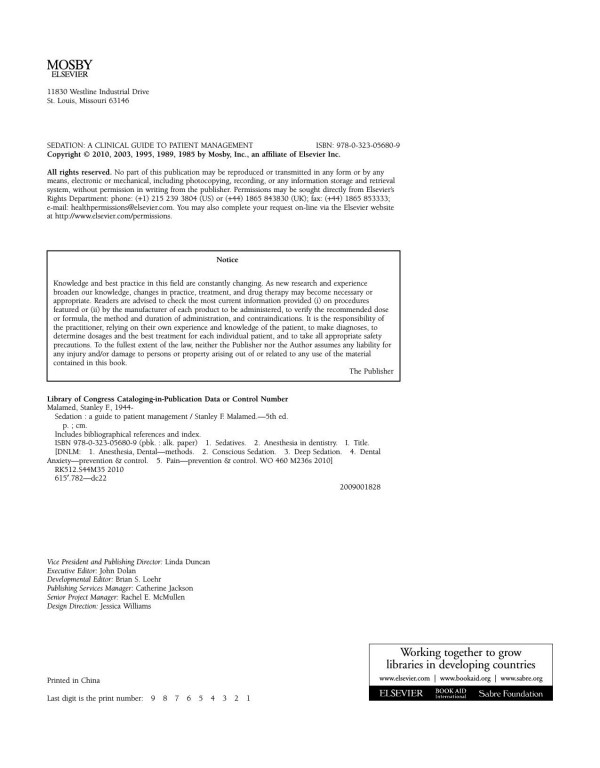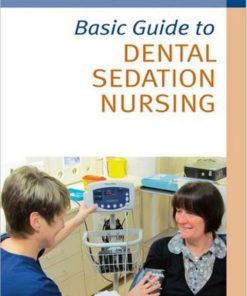Sedation A Guide to Patient Management 6th Edition by Stanley Malamed ISBN 0323400531 9780323400534
$50.00 Original price was: $50.00.$25.00Current price is: $25.00.
Authors:Malamed , Author sort:Malamed , Published:Published:Nov 2011
Sedation A Guide to Patient Management 6th Edition by Stanley Malamed – Ebook PDF Instant Download/Delivery. 0323400531, 9780323400534
Full download Sedation A Guide to Patient Management 6th Edition after payment

Product details:
ISBN 10: 0323400531
ISBN 13: 9780323400534
Author: Stanley Malamed
**Selected for Doody’s Core Titles® 2024 with “Essential Purchase” designation in Dentistry** Learn how to safely sedate your dental patients and help control their anxiety with Sedation: A Guide to Patient Management, 6th Edition. Written by sedation expert Stanley Malamed, DDS, this concise guide combines essential theory with “how-to” technical instruction to help you master basic techniques in dental sedation and anxiety control. This new sixth edition also incorporates the latest guidelines from the ADA and the American Society of Anesthesiologists, along with vivid images of the most current equipment and procedures used in dental practice today. There is also detailed discussion on how to modify typical treatment protocol to successfully treat different patient populations – including pediatric, geriatric, physically compromised, and medically compromised patients. In all, this is a must-have guide for keeping up to date on the latest techniques in dental sedation and anxiety.
- The latest practice guidelines established by the ADA and the American Society of Anesthesiologists for sedation by non-anesthesiologists are included throughout the text.
- Comprehensive coverage combines all aspects of sedation with essential theory and instruction to cover all the information needed to provide safe and effective dental care.
- Expert authorship from Stanley Malamed, DDS, provides readers with experienced guidance across all areas of sedation dentistry and local anesthesia.
- Summary tables and boxes support visual learners and serve as useful review and study tools.
- Coverage of all potential patient groups details how to manage the pain and anxiety of pediatric, geriatric, physically compromised, and medically compromised patients in addition to the subtle changes that may be needed in normal treatment protocol.
- NEW! Extensive content revisions incorporatethe most up-to-date information on the advances in sedation dentistry including the latest research, clinical experience, and literature.
- NEW! Updated photos and art reflect the latest equipment and procedures used in dental practice today.
Sedation A Guide to Patient Management 6th Table of contents:
Chapter 1: Introduction to Sedation
- Definition and Overview of Sedation
- History and Evolution of Sedation Practices
- Indications and Benefits of Sedation in Clinical Practice
- Types of Sedation: Minimal, Moderate, Deep, and General Anesthesia
- Legal and Ethical Considerations in Sedation
Chapter 2: Pharmacology of Sedative Agents
- Pharmacokinetics and Pharmacodynamics of Sedatives
- Commonly Used Sedative Drugs
- Benzodiazepines
- Barbiturates
- Opioids
- Propofol
- Nitrous Oxide
- Ketamine
- Antihistamines and Others
- Adjuvant Medications: Analgesics, Antiemetics, Anticholinergics
- Mechanisms of Action of Sedatives
- Factors Influencing Drug Selection and Dosage
Chapter 3: Patient Assessment and Selection
- Pre-Sedation Patient Assessment: Medical History and Risk Factors
- ASA Physical Status Classification System
- Special Considerations: Pediatric, Geriatric, and Pregnant Patients
- Psychological Considerations and Anxiety Management
- Contraindications for Sedation
- Informed Consent for Sedation
- Screening for Drug Interactions and Allergies
Chapter 4: Techniques of Sedation Administration
- Routes of Administration: Oral, Intravenous, Inhalational
- Sedation Protocols: Titration, Monitoring, and Adjustment
- Combination Sedation: Using Multiple Agents Effectively
- Nitrous Oxide and Oxygen Sedation: Techniques and Considerations
- Intravenous Sedation: Techniques and Equipment
- Sedation for Special Procedures: Endoscopy, Dental, Minor Surgery
Chapter 5: Monitoring and Safety During Sedation
- Vital Sign Monitoring: Blood Pressure, Heart Rate, Respiratory Rate
- Oxygen Saturation and Capnography
- Sedation Depth Monitoring: Clinical Signs and Objective Tools
- The Role of Pulse Oximetry and Capnometry
- Monitoring Equipment: Setup, Use, and Troubleshooting
- Sedation Risk and Patient Safety Protocols
- Managing Airway and Breathing in Sedated Patients
Chapter 6: Managing Complications and Adverse Reactions
- Common Adverse Reactions to Sedative Agents
- Hypoxia, Hypercapnia, and Hypotension: Prevention and Management
- Over-sedation: Symptoms, Causes, and Interventions
- Respiratory and Cardiac Emergencies
- Allergic Reactions and Drug Toxicity
- Prevention and Management of Intravenous Complications
- Managing Malignant Hyperthermia and Other Rare Complications
Chapter 7: Recovery and Post-Sedation Care
- Recovery Monitoring: What to Look for After Sedation
- Discharge Criteria and Guidelines
- Post-Sedation Care: Observation, Pain Management, and Hydration
- Managing Delayed Reactions or Complications Post-Sedation
- Communication with Post-Sedation Patients and Their Caregivers
- Follow-up Care and Instructions
Chapter 8: Sedation in Special Populations
- Pediatric Patients: Techniques, Dosing, and Safety Considerations
- Geriatric Patients: Sedation Challenges and Adjustments
- Sedation in Pregnant Patients: Considerations and Safety Guidelines
- Sedation in Patients with Coexisting Medical Conditions (e.g., Diabetes, Asthma)
- Sedation for Patients with Mental Health Conditions and Anxiety
- Sedation for Patients with Disabilities
Chapter 9: Legal, Ethical, and Regulatory Issues in Sedation
- Legal Responsibilities and Accountability in Sedation Administration
- National and International Sedation Guidelines and Regulations
- Ethical Issues: Consent, Autonomy, and Confidentiality
- Documentation and Record-Keeping Requirements
- Sedation Training, Certification, and Continuing Education
- Legal Case Studies and Precedents in Sedation
Chapter 10: Innovations and Advances in Sedation
- New Sedative Agents and Their Applications
- Advances in Monitoring Technology
- Computer-Assisted Sedation Systems
- The Role of Artificial Intelligence and Robotics in Sedation
- Sedation in Virtual Reality and Non-Traditional Environments
- Research and Clinical Trials in Sedation Practices
Chapter 11: Case Studies and Clinical Applications
- Case Study 1: Sedation in Pediatric Dentistry
- Case Study 2: Sedation for Endoscopic Procedures
- Case Study 3: Sedation in the Elderly: Practical Challenges
- Case Study 4: Managing Complex Medical Patients with Sedation
- Case Study 5: Sedation in a High-Risk Surgical Procedure
- Clinical Outcomes and Analysis
Chapter 12: Future Directions in Sedation Practice
- Emerging Trends in Sedation Delivery Systems
- Challenges in Sedation Education and Training
- Patient-Centered Sedation Practices: Balancing Comfort and Safety
- The Role of Sedation in Emerging Healthcare Models
- Global Perspectives and Practices in Sedation
People also search for Sedation A Guide to Patient Management 6th:
sedation- a guide to patient management
malamed sf sedation a guide to patient management
sedation a guide to patient management
sedation a guide to patient management pdf
sedation a guide to patient management 6th edition
You may also like…
eBook PDF
Basic Guide to Dental Sedation Nursing 1st Edition by Nicola Rogers ISBN 1444342428 9781444342420












